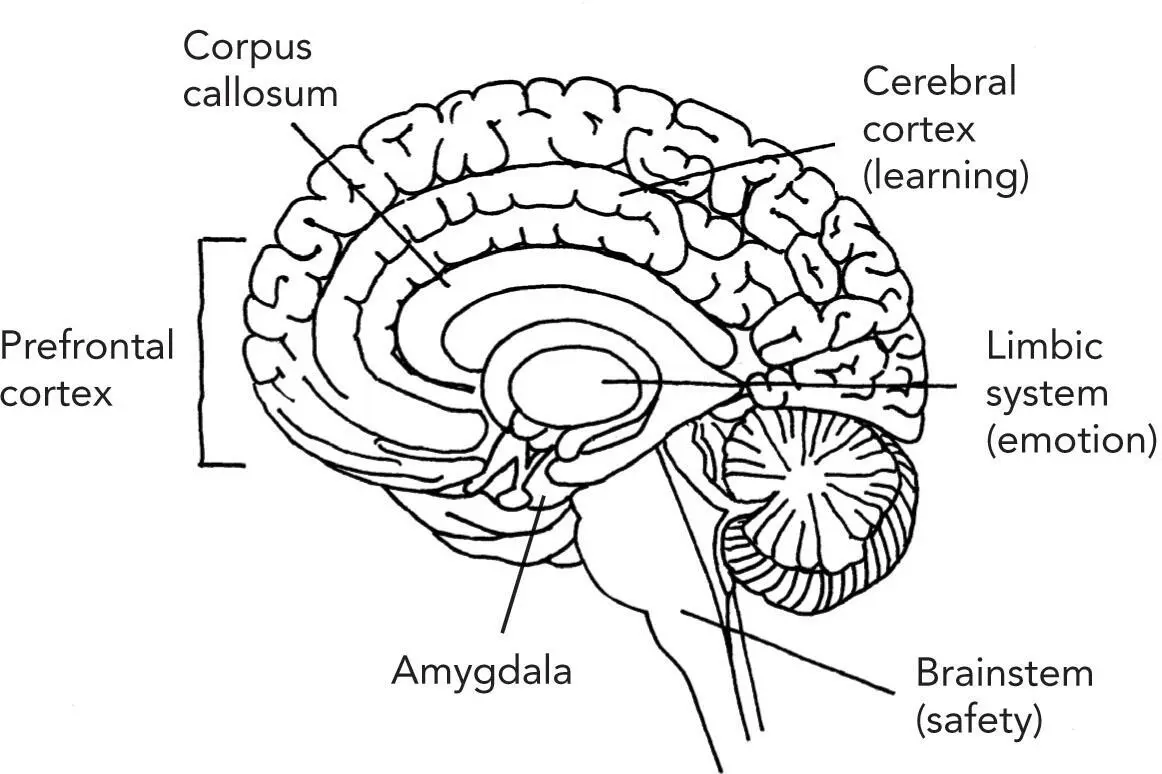Right-hemisphere processes are automatic, fast, and largely unconscious. The right hemisphere works in the here and now, using non-verbal information such as images, and has the capacity to see the big picture, taking an instant snapshot of the situation.
Left-hemisphere processes are deliberate, slower, and conscious. The left hemisphere works by matching current reality with past experiences, using language and calculation to construct stories, explanations and timelines.
The three parts of the brain – and the two hemispheres – function within a hierarchy, with the brainstem at the bottom, the limbic system in the middle, and the cerebral cortex at the top. The later-developing cortex has the power to hold back or refine the more primitive reactions from the sub-cortical structures(the limbic system and the brainstem), giving top-down control.
The right hemisphere, which matures before the left hemisphere, is more concerned with our immediate safety and sense of where we are in the world, while the left hemisphere is more concerned with analysis and setting goals. Likewise, the backof the brain processes raw sensory data (like visual images), while the frontof the brain is more concerned with refining these images through meaning and interpretation. Altogether, our brain develops in a bottom-to-top, back-to-front and right-to-left direction.
To keep things simple, we can see both our right hemisphere and our limbic system and brainstem as dealing primarily with feeling, and our left hemisphere as dealing mainly with thinking.
The feeling system is primed for survival– including our essential physical processes and the fight–flight reaction. It runs on raw, unprocessed data: when a large dog suddenly appears in front of us, all we need to see and sense is that it’s angry and growling, not its name, species or favourite park. The defining feature of this survival system is speed. Because it’s linked to emotions such as fear, it has been described as ‘the hot system’. I call this system RED.
THE HUMAN BRAIN
Internal structure – Side view

On the inside, the human brain is organised into three main functional areas: the brainstem at the base; the limbic system in the middle; and the cerebral hemispheres at the top.
The thinking system is primed for potential. Once we’re safe from the dog, we can think about how to avoid crossing its path in future – maybe we need to buy an even bigger dog ourselves! This system allows us to solve problems, set goals, learn and adapt. Because it’s linked more to thinking and rational analysis, it has been described as ‘the cool system’. I call this system BLUE.
The RED system is strongly connected to our body through powerful nerves, to maintain the overall functioning of our body and main organs within certain, comfortable limits, and to allow us either to run away or to defend ourselves when the situation demands.
There are two RED brain abilities that are particularly relevant to performance under pressure:
1 Emotional regulation
2 Fight–flight–freeze
The RED system runs essential physiological processes like sleep, hunger, thirst, sex drive and our heart and lung function. We don’t want to think much in most of those situations, so the RED system runs our internal worldautomatically and unconsciously by monitoring sensory information from our main organs. And we can’t switch it off – it never sleeps, even when we do.
Our RED brain is also constantly monitoring emotional information from our external world.It processes multiple information channels simultaneously to keep pace with cues in our social and emotional environment. The RED system regulates (controls) our emotions, and since our emotional self-control directs our behaviour at all times, the RED system sits at the forefront of how we experience the world around us.
Our RED brain specialises in processing social and emotional information in a non-linear, holistic way. To give us vital split-second reactions, it runs on broad images, impressions and feelings, delivering an unending stream of moment-to-moment, gut-based judgments about our constantly changing world.
The trade-off is that a lot of detail is lost or not processed, resulting in an approximate system that provides rapid judgments at the expense of accuracy. Information is combined to provide an overall synthesis of a situation, rather than being broken down into smaller categories.
To understand this, let’s look more closely at the role of the limbic system in regulating our emotions.
The limbic system adjusts our emotional state in two main ways: by regulating our level of arousal, and by controlling whether this feels good or bad. It’s like an extremely powerful internal thermostat, turning our energy level and emotional temperature up and down in an instant.
Nothing is more important to our day-to-day functioning than emotional regulation because it helps keep our body functioning within certain comfortable parameters, where we operate most efficiently. This maintenance of our physical and mental state within a relatively comfortable mid-range or zone is called homeostasis, an essential process for all living organisms. (We will see that understanding – and overcoming – this powerful force to stay comfortable can unlock our performance under pressure.)
Life would be straightforward if we were able to function in comfortable conditions all the time. But we know that in our evolutionary past, we faced deadly threats and had to be constantly on our guard. Think of it in terms of a predator and its prey: the prey either has to react aggressively to deter the predator, or has to get away from the situation in a hurry. We saw this same response earlier in the person confronted by the ferocious dog.
Our RED system has evolved not just to keep us within a comfortable physiological window when conditions are safe and allow it, but also to keep us alive when we face significant threat. It does this through the fight, flight and freeze reactions, which are our stressreactions. Within a split second, our brain and body are ready either to flee from the threat, or to fight it off.
Our two amygdalae, considered the most primitive parts of the limbic system, act as our threat detectors. They’re constantly on high alert and exquisitely sensitive: they can be triggered simply by picking up on the dilation of another person’s pupils, a sign of potential hyper-vigilance or fear. They can respond unconsciously within 30 milliseconds, much faster than the 250 to 500 milliseconds it takes us to consciously focus attention with our BLUE brain. This is why we can find ourselves reacting to something without knowing why; then our conscious BLUE mind will catch up and recognise the threat that our RED system saw a quarter to half a second beforehand. In life-threatening situations, our amygdalae allow us to act first and think later.
If we can’t overcome or get away from our opponent, we feel trapped, and a more primitive reaction can kick in: freeze. This reaction has a slightly different biological pathway from the fight–flight mechanism, and it works in the opposite way: it shuts us down physically. It’s a last-ditch response to danger, when horror kicks in. In the animal world, this is where caught prey plays dead, hoping the predator will lose interest and enable it to escape. In the human world, we look blank and stare. Freeze starts out with a spike of arousal, but then transforms into a profoundly low-arousal state.
Читать дальше













